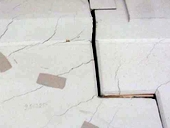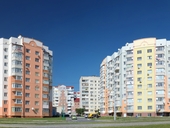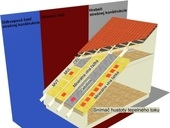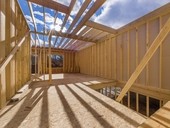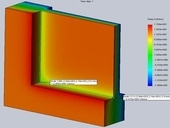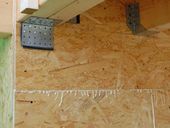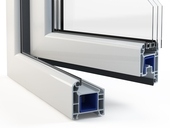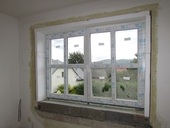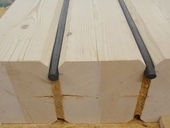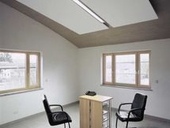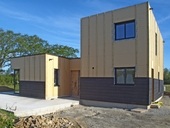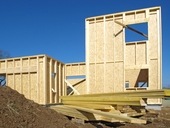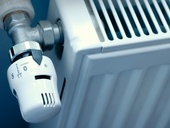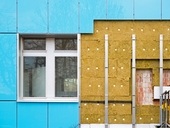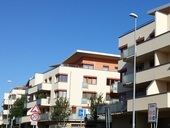Revision of ETAG 004 brought a change in the assessment of noise protection external thermal insulation composite systems (ETICS). Under this revision ETICS may have positive or negative influence on airborne sound insulation of wall on which was applied. The article deals with calculation method of airborne sound insulation, including concrete calculations, and measurements on ETICS with mineral wool.
Archiv článků od 16.2.2015 do 9.11.2015
Buildings which are issued to natural changes of atmospheric temperature, should be divided to parts that can act independently. If not, the structure itself will be split up according to the general laws of physics and the internal and external form and material properties of the structure. The article describes failures of expansion joints of constructions.
The article gives information on the requirements of sunlight in buildings in the European Union and gives a brief historical overview of the normalization of sunlight in our country. On the concrete realization of the residential complex built around 2000 in a closed blocks line is demonstrated the satisfactory insolation in these conditions. From this perspective provides a comment on current events about the preparations of Prague building regulations.
Wilful attack targeted on strategic buildings and critical infrastructure can pose significant thread to property and human lives. By modification of the material traditionally used in building industry, in particular by addition of randomly dispersed fibre reinforcement in currently most spread building material – concrete, the enhancement of the blast and ballistic resistance can be effectively achieved without high additional costs. Within the research works presented in this article, the influence of several types of fibre reinforcement on the blast resistance of the concrete panel was assessed. The results of real blast tests indicates, that incorporation of any type of fibre brings enhancement of the blast resistance of the concrete, but the level is highly affected by strength and shape characteristics of the fibre.
The thermal performance of any building component is the result not only of its thermo-physical properties but also of a way of final installation and connections altogether of their all elements. In addition, thermal leakage and bridging in buildings can eventually contribute to a multitude of problems. The thermal bridge is the place in the building envelope through which heat transfer has a multi-dimensional nature. That is why in recent studies, the issue of heat transfer phenomena in the building components has been taken as a multi-dimensional into account more frequently. One of the specific details that create thermal leakage is located in balcony slabs. This paper is focused on advanced analysis of thermal performance of thermal break element applied in balcony slab with parametric correlation to the thermal properties of wall building envelope. Particular cases of commonly used balcony systems in buildings are observed related to multi-dimensional and parametric approach of modeling. Finally a finding of many aspects, such as building geometry, thermal properties variation and structural type importance are observed as certain influence to thermal bridges magnitude and final thermal performance of balcony slab detail.
The present study reveals the influence of typical wind permeability of connections at the eaves on thermal losses. Therefore, a laboratory test and a field test with different insulation materials and different typical geometries of the gap at the eaves were carried out. In order to show the influence on the heat flow rate dependent on insulation material characteristics, three insulations with different densities and air flow resistances were chosen. Furthermore, in the laboratory test the roof inclination, the insulation thickness and the fixation of the roofing underlayment were varied.for the laboratory test, a part of a roof was constructed in the climate chamber. Hence, an influence on the heat flow rate depending on the insulation material has been detected. Where as cellulose insulation and the heavy mineral wool show no significant reaction of the heat flow under different wind velocities and different gap sizes, the investigated lightweight mineral wool insulation shows an important variation of the Uvalue. For the field test, a typically pitched roof was constructed, the eaves placed in the main direction of the wind. It was shown, that the influence of wind on the heat flow rate is negligible if the gaps at the eaves are masked by a projecting roof. The outcome of the research project will lead to a modification of a national construction standard.
The article describes one of the key factors affecting the lifetime of a wooden building – moisture. It shows the most common causes and effects of increased moisture inside a wooden construction. Methods of determining moisture level in it are listed and particular one suitable for continual monitoring is presented. The suitable method is measuring of the resistance and conversion to a moisture level. Corrections of the moisture level for temperature effects and wood type are included.
These series of articles focuses on the issue in terms of microbial purity level in internal environment, ventilation and heating systems of residential buildings. The issue relative to its scope is divided into several parts, following: Microbial microclimate of buildings and its limits, Collection and cultivation of samples from the family houses, Rating of family houses, Microbial microclimate in educational establishments, Heating surfaces and microbial environment.
The aim of this set of articles is to present methods and results of the subsequent mapping of microbial contamination of the interior of buildings to technical specialists and readers. The questionnaire survey will enable us to evaluate an impact of the MEP systems for indoor environmental quality, especially its microbial component. Those articles will present the work and the results processed in the framework of the specific research Brno University of Technology, Faculty of Civil Engineering, Institute of technical equipment of buildings under project FAST-S-15-2620.
The surface temperature as one of the most watched parametres of the opening panes and light enveopes not only in the Czech Republic is being assessed in a view of risk of water vapour condensation, or more precisely in a view of their health and a hygyenic flaws and ecologically sound environment where inbuilt. The mening is determination if the structure is suitable for the marginal conditions or whether is necessary to choose another structure.
This article deals with the assessment of applicability of OSB boards as the main airtightening layer. Different material thicknesses and various kinds of surface modifications of boards were tested. Measurements were performed with blower-door test in an airtight chamber, which is located in the experimental wooden structure EXDR 1. The article describes a procedure of the experiment and its results.
The surface temperature as one of the most watched parametres of the opening panes and light enveopes not only in the Czech Republic is being assessed in a view of risk of water vapour condensation, or more precisely in a view of their health and a hygyenic flaws and ecologically sound environment where inbuilt. The mening is determination if the structure is suitable for the marginal conditions or whether is necessary to choose another structure.
In the article, I would like to draw attention to the issue with an outside window lintel on existing double glazed windows. The lintel is mounted below the other lintel and can therefore when replacing windows in modern window to form a problem. The article presents possible solutions window lintel. The most appropriate way is a solution that includes the total renovation of the building envelope with the replacement of windows.
This contribution deal with the testing of thermal resistance and derived thermal transmittance of timbered wall from spruce wood beams 300 mm thick according to the standard EN ISO 8990 by Hot Guarded Box method. Thermal conductivity tests of individual layers made from the tested wall were carried out according to the standard ISO 8302 by Guarded Hot Plate method after the test according to the standard EN ISO 8990. These thermal conductivity tests were carried out for the average thermal resistance determination of the wall from the equivalent thermal conductivity and also for the comparison with the value founded by Hot Guarded Box method. The part of the tests was also the determination of mass moisture of individual layers and then the equivalent mass moisture of the wall. The contribution contains the maximal requirement values of thermal transmittance of the exterior walls according to the national standard ČSN 73 0540-2. The contribution contains also informative table of thermal conductivities of the plates of different wood profiles founded by tests or from literature.
Acoustic design brings a new perspective to acoustics. Acoustic design tries to solve our uncomfortable noise conditions at any stage of the building. The easiest way is to solve at design and implementation stage. Situation at the stage of final inspection (stage to prepare to use) is more difficult. The most difficult path to the real solution is in using phase. Acoustic design focuses on the layout of dwellings to each other, the position of rooms within a house or apartments. Acoustic design solves issues of additional installations of suspended ceilings, primary plus secondary (added) walls and other acoustic absorbing elements that reduce reverberation time. Acoustic design also deals with a newly and additionally installed technologies such as modern air-condition units, new lifts, special heat pumps etc. The main point is to get the right balance between acoustic comfort of living and system of building construction using new technologies.
The paper summarizes important information related to the field of design of wooden buildings from the point of view of the sound reduction index. The text is focused on wooden structures (both massive wood systems and wood frame systems) as well as on particularities of an acoustic behaviour of wooden floor structures with fillings. General principles are described which may serve as useful hints for architects and project engineers when designing structures with wooden elements. Emphasis is primarily put on the specific acoustic behaviour of wooden buildings in comparison with masonry and concrete structures.
The main purpose of this paper is to show how the different structural details affect the airborne sound insulation of lightweight building elements. The sound reduction index of such structures depends on several phenomena like the cavity attenuation, the mass-air-mass resonance, standing waves resonance, sound transmission via sound bridges etc. This paper describes their effect on sound insulation and gives the initiative information for optimized acoustic design.
This article is focused on design optimization in naturally ventilated facades. Ventilated facade constructions are designed according to ETAG 034. Thickness of the cavity is defined at least 20 mm. This distance can be reduced locally to 5 mm to 10 mm. In this case, it has to be verified that it does not affect the ventilated function. The minimum cross-sections of ventilation openings at the inlet and at the outlet are also determined at least 50 cm2 per linear meter. The influences of local reductions at inlet and outlet openings are analyzed. Air temperatures and velocities are monitored in the cavity with thickness 20, 40 and 60 mm. Results show that the influence of local reduction increases with increasing cavity thickness.
In the last article on the regeneration of residential buildings, I said that additional contributions will be more focused on topics that are crucial for the effective functioning of the heating system, or which are controversial perception among the general public. The first topic that fully meets the two criteria is the heat transfer between the different flats in apartment houses.
zpět na aktuální články

